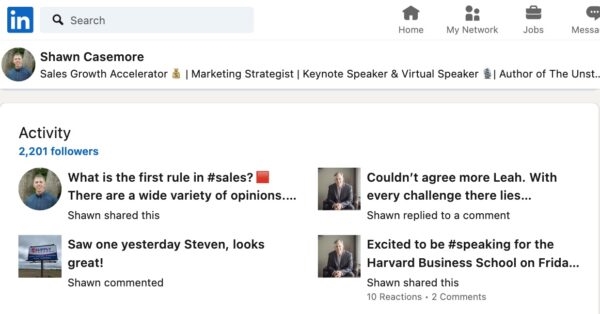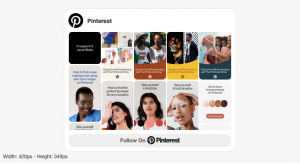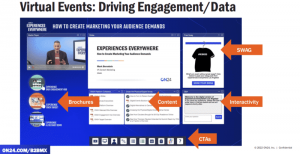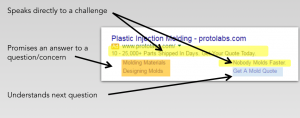You might be wondering how to use social media to sell in person.
After all, you aren’t planning to run ads on social media.
What if I told you that 90% of top salespeople use social selling to close more deals than those who don’t?
They are using what is called social selling, and their results are off the charts.
What Is Social Selling?
Using social media to sell doesn’t mean you need to run Facebook ads or Twitter ads.
It’s about using social media to build brand awareness.
When you consider that 3.2 billion of the world’s population are engaged in using social media, it only makes sense that you have a presence.
Social selling is using social media to find prospects, build relationships, and nurture relationships.
It’s likely you’ve been using social media in this manner already without knowing it.
Social selling is developing a strategy and effort that is more intentional.
But can social selling actually help you sell more?
10% of sales reps who use social selling closed 5 more deals than those who don’t.
The Difference between Social Media Marketing and Social Selling
Social media marketing is typically used in the B2B space in one of two ways.
- To interrupt potential leads, qualify, and convert all in one fell swoop.
- To capture qualified leads for follow-up.
For the first option, social media marketing can be successful, depending on the product.
A t-shirt or new socket wrench are often the most successful being sold in this manner.
Using social media marketing to capture leads can be successful, but the challenge lies in the cost associated with conversion.
The typical costs include:
- A retainer for an agency to design and launch the ads.
- The cost of running the paid ads on the social platform.
- Costs associated with further qualifying the lead, typically by staff.
Social selling eliminates much of these costs and focuses on what matters most in selling: building relationships.
There are no agency fees (unless you have them post on your behalf), no paid ads to run, and conversion is a natural evolution.
Each time I comment, like, or post on LinkedIn, I’m engaging in social selling. Everyone within my network (first, second, and third connections) can see my posting activity.
If it’s relevant, they’re likely to review or read, and possibly even engage with a comment or message.
That’s social selling at its best.

There’s no paid advertising, and I’m not trying to convert but rather begin building a relationship.
As I grow my network with prospective customers and referral sources, my relationships continue to grow.
Selling Using Social Media in 2021
This might sound great, but how does it support making a sale?
Using social media to sell requires that you do the work to convert your prospect.
In my earlier example, although LinkedIn is a great source for connecting with potential leads and building relationships, I’m not trying to make a sale directly.
This isn’t to say that you can’t sell direct through these platforms.
If you’ve engaged in using the DM feature on Facebook, Twitter, or LinkedIn and helped a customer make a buying decision right then and there, then you’ve converted.
But it took your effort to do so.
That’s the key.
If the product or service you are selling requires a deeper dialogue, more information, or explanation, then social selling is your best option.
There are five ways you can use social media to sell in 2021:
-
Build awareness:
Having a presence on the social networks that your prospects engage on builds awareness.
Reaching out and connecting on LinkedIn, for example, allows you to start dialogues with prospects, and opens opportunities to move to offline conversations.
-
Attract your ideal prospect:
If you publish content or share and like posts on the platforms your prospects engage on, you have a means of gaining their attention.
LinkedIn, Facebook, and Twitter all provide opportunities to use hashtags, which are how others search for the topics you publish on. Use the hashtags your prospects search for and they’ll be attracted to you.
-
Create intrigue:
It’s not enough to publish content and engage with other posts. You need a means to stand out. Don’t be afraid to be provocative or share content that gets your prospects thinking.
Challenge what they believe to be true about your product or service by featuring comparisons of your competitors’ products versus yours.
-
Convert your network:
Where social networks offer the greatest opportunity is in conversion. As you gain the attention of your prospect, you’ll want to reach out and begin a discussion.
Suggest ideas that may be of assistance and then ask to engage offline. This could be in the form of a call or meeting. Once you have their attention, move towards an off-platform conversation.
-
Expansion opportunities:
Social networks offer an easy method for you to gain referrals and expand your networks. Most platforms today will make suggestions of who you can connect with, which are based on contacts of your direct network.
Not only this, but some platforms will even offer you the chance to view and reach out to your extended network.
LinkedIn Sales Navigator is a great way to view second and third levels of contacts that you can ask for introductions or referrals to.
Putting Social Selling to Work for You
As more people become engaged in using social media, as a sales professional, social selling becomes a powerful tool for your sales arsenal.
Find the platform that most of your prospects engage on, then begin posting, sharing, connecting, and engaging to build trust and rapport.
As your network grows, begin moving your contacts to offline conversations and watch your sales opportunities explode!
Digital & Social Articles on Business 2 Community
(53)
Report Post







